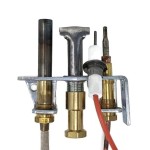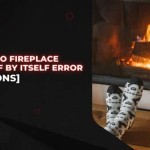The Importance of Damper Functionality in Gas Fireplaces
Gas fireplaces offer a convenient and aesthetically pleasing alternative to traditional wood-burning fireplaces. They provide instant warmth and ambiance with the flick of a switch or the press of a button. However, like any combustion appliance, a gas fireplace requires careful maintenance and understanding of its components to ensure safe and efficient operation. One critical component often overlooked is the damper.
While traditional fireplaces rely heavily on a damper to control airflow and prevent heat loss up the chimney when not in use, the role of a damper in a gas fireplace can be subtly different but equally important. Understanding how a gas fireplace damper works, its purpose, and potential issues can prevent problems ranging from energy waste to carbon monoxide buildup, thereby enhancing the overall safety and efficiency of the appliance.
This article will delve into the intricacies of gas fireplace dampers, exploring their functionality, troubleshooting common problems, and addressing safety concerns related to their proper operation. It will focus on providing clear, informative guidance to help homeowners understand and maintain this crucial component of their gas fireplace system.
Understanding the Role of a Damper in a Gas Fireplace
The term "damper" in the context of a gas fireplace can be misleading since its function often diverges significantly from the traditional damper found in wood-burning fireplaces. A traditional fireplace damper is a metal plate that seals off the chimney when the fireplace is not in use, preventing cold air from entering the home and warm air from escaping. While some gas fireplaces utilize a similar damper setup, many modern gas fireplaces, particularly those classified as direct vent or vent-free models, may not even have a conventional damper.
In many gas fireplaces, especially older models designed to vent into an existing chimney, a damper mechanism is present. However, it's designed to remain partially open at all times. This is crucial because gas fireplaces produce byproducts of combustion, including carbon monoxide. A completely closed damper would prevent these gases from escaping, creating a potentially lethal situation.
The purpose of the "damper" in these systems is more accurately described as a restrictor plate or flue restrictor. It’s often a small metal plate within the flue designed to regulate the airflow. This regulated airflow helps maintain optimal combustion efficiency and prevents excessive heat loss when the fireplace is not in use. The degree to which this restrictor plate is open is usually factory-set based on the specific fireplace model and the venting system.
Direct vent gas fireplaces, on the other hand, have a sealed combustion chamber that draws air from outside the home and vents exhaust gases directly outside through a dedicated two-pipe system. These fireplaces typically do not require a damper because the sealed system inherently prevents backdrafting and heat loss. Similarly, vent-free gas fireplaces, which are designed to burn very cleanly and release minimal exhaust gases into the room, also typically do not utilize dampers. However, vent-free fireplaces require strict adherence to manufacturer specifications regarding room size and ventilation for safe operation.
Therefore, the function and presence of a damper in a gas fireplace depend heavily on the type and design of the fireplace. It is important to identify the type of gas fireplace installed in a home to understand the specific role of any damper-like mechanism present.
Troubleshooting Common Damper-Related Issues
Even though the "damper" in a gas fireplace might be a restrictor plate or not present at all, understanding potential issues related to airflow and venting is critical for safe and efficient operation. Gas fireplace problems that are often misattributed to a malfunctioning damper can include:
Drafting Issues: A common problem is a noticeable draft coming from the fireplace when it is not in use. In older gas fireplace systems with a partially open damper, a slight draft is normal. However, an excessive draft might indicate an issue with the venting system, such as a disconnected or damaged vent pipe. Inspecting the venting system for any leaks or obstructions is crucial. Also, ensure that the flue restrictor plate is set to the correct position as specified by the manufacturer. If the restrictor plate is missing or damaged, it needs to be replaced by a qualified technician.
Pilot Light Problems: A flickering or extinguished pilot light can sometimes be attributed to poor drafting. Strong drafts can blow out the pilot light or prevent it from igniting properly. Ensuring the venting system is clear and free of obstructions is essential. Additionally, check for other potential causes of pilot light problems, such as a dirty pilot light assembly or a faulty thermocouple.
Soot Buildup: Incomplete combustion can lead to soot buildup on the fireplace glass or within the venting system. This can occur if the air-to-fuel ratio is not properly balanced. While not directly related to the damper in all cases, restricted airflow caused by a partially blocked venting system can contribute to incomplete combustion. Regular cleaning of the fireplace and venting system is necessary to prevent soot accumulation.
Unusual Odors: A persistent gas odor, even when the fireplace is not in use, requires immediate attention. This could indicate a gas leak in the supply line or a problem with the venting system allowing exhaust gases to seep into the room. Immediately shut off the gas supply to the fireplace and contact a qualified gas appliance technician to inspect and repair the system. Ensure the venting system is properly sealed and that exhaust gases are being effectively removed from the home. The presence of unusual odors that are not immediately identified as natural gas, such as a burning or acrid smell, could also indicate improper combustion, which could be related to airflow restrictions.
Carbon Monoxide Concerns: Carbon monoxide (CO) is a colorless, odorless, and deadly gas produced by incomplete combustion. A malfunctioning venting system or a blocked flue can lead to CO buildup in the home. Installing and maintaining carbon monoxide detectors is crucial for detecting CO leaks. If a CO detector alarms, immediately evacuate the premises and contact emergency services. Inspecting the venting system annually by a qualified technician is recommended to ensure it is functioning properly and preventing CO buildup.
When troubleshooting gas fireplace issues, it's important to differentiate between problems directly related to a malfunctioning damper (if one exists) and problems stemming from other factors, such as gas supply issues, pilot light problems, or venting system malfunctions. Consulting the fireplace's owner's manual and seeking professional assistance from a qualified gas appliance technician is always recommended when dealing with gas fireplace problems.
Safety Precautions Regarding Gas Fireplace Dampers and Venting
Safety should always be the paramount concern when dealing with gas fireplaces. Due to the risk of carbon monoxide poisoning, proper maintenance and understanding of the venting system are crucial. Regardless of whether the gas fireplace uses a traditional damper, a restrictor plate, or no damper at all, several safety precautions should be observed:
Regular Inspections: Schedule an annual inspection of the gas fireplace and venting system by a qualified gas appliance technician. The technician can inspect the venting system for any damage, obstructions, or corrosion and ensure that the fireplace is operating safely and efficiently. This includes checking the integrity of the vent pipes, the connections, and the proper draft.
Carbon Monoxide Detectors: Install carbon monoxide detectors on every level of the home and near sleeping areas. Test the detectors regularly to ensure they are functioning properly. Replace the batteries at least once a year or according to the manufacturer's instructions. Be aware of the symptoms of carbon monoxide poisoning, which can include headache, dizziness, nausea, vomiting, and confusion.
Proper Ventilation: Ensure adequate ventilation in the room where the gas fireplace is located, especially if it is a vent-free model. Follow the manufacturer's recommendations regarding room size and ventilation requirements. Never block or obstruct the air vents or louvers on the fireplace.
Professional Repairs: Never attempt to repair a gas fireplace yourself unless you are a qualified gas appliance technician. Gas lines and venting systems require specialized knowledge and equipment. Incorrect repairs can lead to gas leaks, carbon monoxide poisoning, or other safety hazards. Always hire a licensed and qualified technician to perform any repairs or maintenance on the gas fireplace.
Owner's Manual: Consult the owner's manual for specific safety instructions and maintenance recommendations for the gas fireplace model. The owner's manual will provide detailed information about the fireplace's operation, venting requirements, and troubleshooting tips. Keep the owner’s manual readily accessible for reference.
Avoid Obstructing Vents: Never hang decorations or place flammable materials near the gas fireplace vents. These items can obstruct airflow and create a fire hazard. Keep the area around the fireplace clear of any combustible materials.
Understand Venting System Requirements: Be aware of the specific venting requirements for the gas fireplace model. Direct vent fireplaces require a specific type of vent pipe that is designed for use with gas appliances. Never use unapproved vent pipes or modify the venting system in any way. Improper venting can lead to carbon monoxide buildup and other safety hazards.
By following these safety precautions and understanding the function of the damper or venting system in a gas fireplace, homeowners can ensure safe and efficient operation of their appliance and protect themselves and their families from potential hazards.

How To Open A Chimney Damper Traditional Fireplace Pros

How Do Fireplace Dampers Work Zoro Com

What Is A Chimney Damper Full Service

Chimney Damper Usage Montgomery County Pa Wells

Types Of Diffe Chimney Dampers Severna Park Pasadena Md

Top Mount Vs Throat Dampers Fireplace Damper Portland Oregon

Everything You Need To Know About Chimney Dampers All Pro Service

The Damper Clamp Im Home Inspections

Fireplace Damper Repair Full Service Chimney Kansas City

Vented Vs B Vent Direct Free Dixie S
Related Posts








